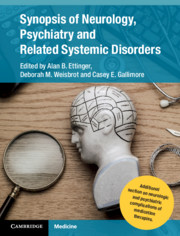Book contents
- Synopsis of Neurology, Psychiatry, and Related Systemic Disorders
- Synopsis of Neurology, Psychiatry, and Related Systemic Disorders
- Copyright page
- Dedication
- Contents
- Contributors
- Preface
- Section 1 Diagnostics
- A
- B
- C
- D
- E
- F
- G
- H
- I
- J
- K
- L
- M
- N
- O
- P
- R
- S
- T
- U
- V
- W
- X
- Z
- Section 2 Medication Adverse Effects
- Index
- References
E
from Section 1 - Diagnostics
Published online by Cambridge University Press: 30 May 2019
- Synopsis of Neurology, Psychiatry, and Related Systemic Disorders
- Synopsis of Neurology, Psychiatry, and Related Systemic Disorders
- Copyright page
- Dedication
- Contents
- Contributors
- Preface
- Section 1 Diagnostics
- A
- B
- C
- D
- E
- F
- G
- H
- I
- J
- K
- L
- M
- N
- O
- P
- R
- S
- T
- U
- V
- W
- X
- Z
- Section 2 Medication Adverse Effects
- Index
- References
- Type
- Chapter
- Information
- Synopsis of Neurology, Psychiatry and Related Systemic Disorders , pp. 169 - 197Publisher: Cambridge University PressPrint publication year: 2019



